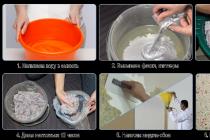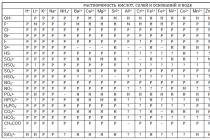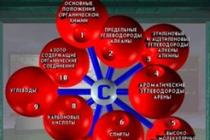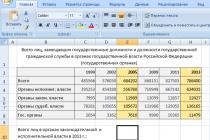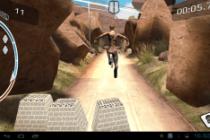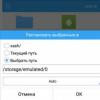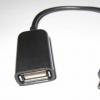8.4. Configuration methods
8.4.1. Definition of absolute configuration
To determine the absolute configuration, two methods are used: an experimental study of anomalous X-ray diffraction by the nuclei of heavy atoms and a theoretical calculation of the magnitude of optical rotation.
8.4.1.a. X-ray diffraction
Due to the fact that X-rays pass through crystals give a diffraction pattern, the method of X-ray structural analysis (XRD) is widely used to establish the structure of chemical compounds. When diffraction occurs on the electron shells of light atoms (C, H, N, O, F, Cl), the nature of the observed interference pattern is determined only by the presence of the nuclei themselves, but not by their nature. This is explained by the fact that light atoms only scatter X-rays, but do not absorb them, and therefore, during the experiment, the phase of the scattered radiation does not change.
Heavy atoms not only scatter, but also absorb X-rays in certain regions of the absorption curve. If the wavelength of the incident radiation coincides with the initial weakly absorbing portion of this curve, then not only ordinary diffraction is observed, but also a certain phase shift of the scattered radiation, due to the fact that part of it is absorbed. This phenomenon is called abnormal X-ray scattering. In the presence of only light atoms, X-ray structural analysis makes it possible to determine the internuclear distances between bound and unbound atoms and, on their basis, draw conclusions about the structure of a given molecule and the presence of chiral elements in it. In this case, the enantiomers cannot be distinguished. However, in the presence of heavy atoms, the character of anomalous scattering depends not only on the distance between atoms, but also on the relative position in space. The phenomenon of anomalous X-ray diffraction makes it possible to directly determine the absolute configurations of molecules containing heavy atoms, as well as molecules into which heavy atoms can be introduced as special labels.
For the first time such an analysis was carried out by Beifut in 1951, who, on the basis that the Ka-emission of zirconium coincides with the beginning of the absorption band of rubidium, and the La-emission of uranium - with the beginning of the absorption band of bromine, for the first time established the absolute configuration (+) - sodium rubidium tartrate (XXVIII ) and hydrobromide (-) - isoleucine (XXIX).
After establishing the absolute configuration of compound XXVIII, it turned out that the previously arbitrarily chosen configuration of (+) - glyceraldehyde turned out, surprisingly, to be guessed correctly.
At present, using PCA, the absolute configuration of several hundred compounds has been determined. It should be said that manual analysis of anomalous diffraction patterns is an extremely laborious process. However, with the help of modern automatic diffractometers equipped with computers, this takes only a few days.
8.4.1.b. Theoretical calculation of optical rotation
In 1952, a quantum-chemical calculation of the optical rotation of zantiomers was published using the example of trans-2,3-epoxybutane (XXX). The configuration of this epoxide can be correlated with the configuration of tartaric acid and further with glyceraldehyde. At the same time, it was again found that the previously arbitrarily chosen stereo formula of D-glyceraldehyde is absolutely correct and there is no need to change the image of this configuration accepted in the literature for many years.

8.4.2. Determining relative configuration
In determining the relative configuration, a connection with an unknown configuration is associated with another connection, the configuration of which is already known. Let's consider the most important of these methods.
8.4.2.a. Chemical correlation
The chemical methods that can be used to establish relative configurations are very diverse and so closely intertwined with the general material of organic chemistry that they are found in almost all the chapters of this book devoted to the consideration of individual classes of organic compounds. Therefore, here we will consider, with a few examples, only the basic principles of their application.
The first group of methods is associated with the transformation of a compound with an unknown configuration into a compound with a known configuration or the formation of an unknown configuration from a known chiral element without disruption, for example, a chiral center. Since the chiral center is not affected during the transformation, it is obvious that the product must have the same configuration as the starting compound.
In this case, it is not at all necessary that if the unknown compound belongs to the (R) -series, then the known one will also have the (R) -configuration. For example, in the reduction of (R) -1-bromo-2-butanol to 2-butanol without affecting the chiral center, the product will be the (S) -isomer, despite the fact that its configuration has not changed. This is due to the fact that the CH 3 CH 2 group, by definition (see section 8.3.3.) Is younger than the BrCH 2 group, but older than the CH 3 group.

One of the many examples of chemical correlation is the establishment of the relative configuration of D-galactose (XXXI) by its oxidation. Since this process leads to the formation of an optically inactive dicarboxylic acid, the relative configuration of its four chiral centers can correspond to either structure XXXII or structure XXXIII. But dicarboxylic acid (XXXIV), obtained from galactose by oxidative cleavage of an aldehyde carbon atom, is optically active. Therefore, D-galactose has a relative configuration shown by formula XXXI.

Similar transformations with L-galactose give the same results, except for the opposite sign of optical rotation. Consequently, in a similar way it is possible to find out only the relative configuration of the studied molecules (in this case XXXI and XXXII), but not their absolute configurations.
Below is an example of the configurational correlation of (+) - tartaric acid with (+) - (R) -glyceric aldehyde based on transformations that do not affect the asymmetric center.

The second group of chemical correlation methods is based on the transformation at the chiral center, the mechanism of which is precisely known. Thus, the reaction S N 2 occurs with the reversal (inversion) of the configuration of the reaction center (see Chapter 9). Using a sequence of such reactions, the (+) - lactic acid configuration was correlated with the (S) - (+) - alanine configuration.

It should be emphasized that the concept of "reversal" or "retention" of a configuration is applicable to achiral reaction centers and serves to indicate a specific reaction mechanism. However, when it comes to the absolute configurations of chiral reaction centers (which are determined by the rules of sequential precedence within the R, S-nomenclature), it makes no sense to invoke the concepts of "inversion" or "preservation" of a configuration, since this or that configuration is determined only by the seniority of the substituents, and the change in seniority as a result of the substitution of one of the groups does not have to coincide with the real spatial orientation of its entry into the molecule, for example:

The third group includes biochemical methods. In a series of one class of compounds, for example, amino acids, a certain enzyme attacks molecules of only one configuration. If some enzyme, say, attacks only the (S) -amino acids, without touching the (R) -form, and this has been experimentally established in a number of examples, then another amino acid exposed to the action of the same enzyme must belong to (S) - row.
How to designate the configuration of a compound so that the name can be used to depict the spatial arrangement of groups at a chiral carbon atom? To do this, use R, S-system proposed by K. Ingold, R. Kahn, Z. Prelog. R, S-system is based on the determination of the seniority of the substituents around the chiral center. The seniority of the groups is determined as follows:
1). The atom with the higher atomic number is the highest relative to the atom with the lower atomic number.
2). If the atoms directly connected to carbon C * are the same, then it is necessary to consider the precedence of the subsequent atoms.
For example, how to determine the older of the groups: -C 2 H 5 and CH (CH 3) 2 in the compound

In the ethyl group, the atom connected to the chiral center is followed by H, H and C, and in the isopropyl group - H, C and C. Comparing these groups with each other, we establish that the isopropyl group is older than the ethyl group.

3). If the chiral carbon C * is connected to an atom that has a multiple bond, then the bonds of this atom should be represented as simple bonds.

4). In order to establish the configuration of the molecule, it is positioned so that the bond of the chiral center with the minor group number 4 is directed away from the observer, and the location of the remaining groups is determined (Fig. 2.6).

Rice. 2.6. Definition R, S-configurations
If the precedence of the groups decreases (1®2®3) clockwise, then the configuration of the chiral center is defined as R(from the Latin word "rectus" - right). If the seniority of the substituents decreases counterclockwise, then the configuration of the chiral center is S(from the Latin "sinister" - left).
The sign of optical rotation (+) or (-) is determined experimentally and is not associated with the designation of the configuration ( R) or ( S). For example, dextrorotatory 2-butanol has ( S) -configuration.
In order to determine the configuration of the connection depicted by Fisher's projection formula, proceed as follows.

1). An even number of permutations of substituents at the chiral center is performed (an odd number of permutations will lead to an enantiomer) so that the junior substituent number 4 is at the top or bottom.

2). Determine the location of the remaining groups, bypassing them in descending order of seniority. If the seniority of the substituents decreases clockwise, then the initial configuration is determined as R-configuration, if counterclockwise, then the configuration is defined as S-configuration.
If it is not easy to transform the projection formula, you can set the order of decreasing precedence by discarding the junior substituent on the side, but choose the "inverse" symbol to denote the configuration. For example, in the original connection

discarding the junior substitute (H), we establish the order of decreasing the seniority: 1 → 2 → 3. We get the notation ( S), change it to ( R) and get the correct name: ( R) -2-chloroethanesulfonic acid.
Determining the computer configuration
Laboratory work
Computer science, cybernetics and programming
Program capabilities - identification of processors and coprocessors from Intel AMD Cyrix VIA Centaur IDT Rise Transmeta NexGen UMC IBM Texas Instruments CT IIT ULSI National Semiconductor SiS; - determination of the processor clock frequency of the multiplier and the system bus frequency determination of the original, without taking into account the overclocking of the processor frequency, the slot socket type and the processor packaging type Platform ID, the determination of the capabilities supported by the processor MMX SSE SSE2 SSE3 3DNow 3DNow Extensions and more ...
DEFINING YOUR COMPUTER CONFIGURATION
Purpose of work: study the basic methods and tools for determining the configuration of a PC, get an idea of the advantages and disadvantages of various methods of obtaining information about the hardware of a computer
To carry out the laboratory work, you need to determine the configuration of the PC using standard software and one of the test programs of your choice.
Brief theoretical information
Windows built-in tools
The list of devices installed in the system can be obtained using the standard hardware manager:
The following steps must be performed sequentially: Start Setting Control Panel System
The System dialog box opened as a result of the actions performed has seven tabs.
- "General" - the tab is designed to provide information about the installed operating system, active user, serial number, brand of the central processor and the amount of installed RAM. This tab is also available by pressing the keyboard shortcut
+ . - Computer name - displays the computer name, workgroup and domain (if any) to which it belongs. The tab also allows you to change these parameters.
- "Equipment" - the tab contains tools for installing hardware, the choice of actions when new devices are detected (the "driver signing" tool). To view the list of installed equipment, use the Device Manager tool. The wizard is designed to provide information about all installed devices, such as drivers used, interrupts, memory addresses, DMA channels, etc. and their settings. Also on this tab is the tool "Equipment profiles», Which allows you to set and store various configurations of equipment.
- "Additionally"- the tab includes three tools. "Performance "- designed to provide information about the installed RAM, activate various modes, for example, 32-bit support from the file system, etc. Windows XP this tool provides customization of visual effects to increase the speed or improve the appearance of the operating system interface. In addition, the wizard allows you to adjust the size of the paging file and optimize the performance of the processor and RAM.
This tab also includes a User Profiles customization tool such as desktop settings, list of available programs, and more. Another tool available from this tab, Startup and Recovery, allows you to view and edit the list of operating systems and assign actions to be taken in the event of a system failure.
- "Automatic update"Allows you to customize Windows Update options.
- "Remote use"includes tools for configuring remote access to this PC for control and configuration.
- "System Restore"- a tab for configuring control over system changes and the ability to cancel unwanted changes.
To determine the models and types of connected devices, use the "Device Manager" tab. There are two options for displaying information about installed devices.
1. Devices by type- when this mode is specified, the installed devices are divided into types. Let's describe some points:
Disk drives- this item reflects the number of installed IDE hard drives and floppy drives (for Windows 98 or Me operating systems). If you are using Windows 2000 or Windows XP, this item reflects the model name of the installed hard disk.
SCSI controllers and RAID - this folder contains controllers used to connect hard drives, scanners, etc. Sometimes a virtual disk program is left here, for example Paragon CD Emulator
Network cards - here is the model of the network card. If there is a connection to the Internet, the Remote Access Controller will also be indicated here, which, in principle, is not a real device.
System devices- all devices located on the motherboard are indicated here, such as the system speaker, BIOS, CMOS, etc. There is no information about the motherboard model at this point. However, there is some information about the microcircuits used in the chipset.
2. Connection devices- when specifying this mode, you can get the same information about the installed devices, only the sequence of its display will be changed. As a result, you can find out which devices are connected to the PCI bus or to the IDE controller.
Model name of the connected printer can be found by following the Start sequence Settings Printers.
Some information about the connected joysticks can be obtained in the Control Panel, the Game devices item.
The volume of the hard disk is determined from the Properties item of the context menu of the hard disk (invoked from the window "My Computer" or the Explorer with the right mouse button).
The clock speed of the central processor is determined when you turn on or restart the PC in the BIOS properties.
External vendor testing programs
Computer testing programs are mainly designed to check the stability of the operation of both individual components and the entire system as a whole, as well as to evaluate performance and compare test results with other computers / components. Also in such programs there are additional features for the correct assessment of the quality of the computer as a whole or its individual specific component. This allows you to get a complete report on the computer and / or its individual components.
Most of the existing test programs are synthetic, while on real tasks (especially, data archiving) the computer may show slightly worse results. Sometimes it is very difficult to find a compromise between real performance and benchmarks, so for comparison with other results, some average indicator is used, which allows you to at least relatively judge the speed of a particular system.
There is a huge variety of programs that can be both universal, that is, designed for testing all PC systems, and for working with strictly defined types of devices, for example, a hard disk or a central processor.
Consider the most popular means of determining the configuration of a PC.
1. Sisoft Sandra program
Software tool for analysis and diagnostics of hardware company PC Catalin - Adrian Silasi - SiSoft Sandra Professional screenshot of the program in fig. 1
SiSoft Sandra ("System Analyzer, Diagnostic and Reporting Assistant ") is a utility for collecting information and diagnosing a system, written under Win 32 "s ... The offered information about the system state and settings of Plug-and-Play devices is, in the opinion of the authors, the most complete, since it includes undocumented sources of information. SiSoft Sandra is a 32-bit application that takes advantage of all the enhancements developed for the MS Windows operating systems.
The program provides the ability to work with 4 types of modules:
Information Modules ... - in this window there are modules with which you can find out information about installed devices. For example, when choosing the information module Mainboard Information, you can find out the model of the motherboard and the type of chipset used, the frequency of the system bus, the type of memory modules installed, and much more.
Benchmarking Modules - This window contains modules designed to thoroughly check the performance of each of the installed devices, as well as to compare their speed with the reference indicators of other models.
Listing Modules - this window contains links to all text files available for reading in normal mode, that is, without additional decryption. This allows you to make sure that certain drivers are loaded into the computer's memory, etc.
Testing Modules - in this window there are modules that allow you to test the computer for basic parameters, such as the absence of DMA channel conflicts, interrupts, etc.
2. Program H winfo 32
Hardware Info is designed to identify the components of a personal computer: after benchmark tests, very detailed information about the processor, motherboard, hard drive, video card, RAM, PCI devices, monitor, audio and network controller, ports, and so on will be displayed. In addition, HWiNFO takes readings of sensors integrated into the system, designed to measure processor temperature, fan speed, etc. If necessary, you can also carry out a comparative analysis of the performance of both the entire PC as a whole, and its individual devices - for example, a hard disk or a CPU. The utility is available in two versions, adapted to work under the operating system DOS or Windows 9x / ME / NT / 2000 / XP. Other features of HWiNFO are listed below:
3. Program A ida 32
The information provided by AIDA32 is grouped by tabs. Each tab, in turn, often has several of its internal sections containing more specific information. Themselves informational tabs in the program 15:
Summary - summary information about the system.
Motherboard - detailed information about the processor, its current load, motherboard, memory, chipset, BIOS.
OS - detailed information about the operating system, including a list of current processes and dll files.
Video - information about the video subsystem, including monitor, DirectX and OpenGL.
Multimedia - information about multimedia devices
Drives - information about drives.
Input - information about input devices.
Devices - information about all devices. It is possible to view devices in Windows view, as well as by connection method.
Network - information about the network, including network resources, a list of mail accounts, Internet Explorer cookies, etc.
Software - Lists installed software, startup programs, and registered file types.
Files - configuration files.
Config - list of environment variables and content of the control panel.
Misc - information about power management, DMI, ODBC, etc.
Tools - create a system report with the ability to send it by e-mail, dump the contents of BIOS, Video BIOS, IDE, PCI.
4. ASTRA 32 program
ASTRA32 - Advanced System Information Tool.The program for determining the configuration of the computer. Allows you to get detailed information (including undocumented) about the processor, cache, motherboard, hard drives, CD / DVD, SCSI devices, memory modules, chipset, BIOS, PCI / AGP, USB and ISA / PnP devices, DMI / SMBIOS, monitor, video card, sound and network card, printer, installed programs and much more. Creation of a report file, the ability to export data to computer accounting programs. Ability to work in command line mode.
Program features
Identification of processors and coprocessors from Intel, AMD, Cyrix, VIA, Centaur / IDT, Rise, Transmeta, NexGen, UMC, IBM, Texas Instruments, C&T, IIT, ULSI, National Semiconductor, SiS;
Determination of the processor clock frequency, multiplier and system bus frequency, determination of the original (excluding overclocking) processor frequency, slot, socket type and packaging type (Platform ID) of the processor, determination of the capabilities supported by the processor (MMX, SSE, SSE2, SSE3 , 3DNow !, 3DNow! Extensions, and more), cache size and parameters
Determining the motherboard manufacturer and site URL, determining the manufacturer, BIOS date and version, determining the manufacturer and model of the chipset
Determining the model and capacity of ATA / ATAPI devices (hard drives, CD / DVD devices, ZIP drives). Determination of PIO, DMA and UltraDMA modes (including those active in this configuration). Work with ATA / ATAPI devices on external UDMA / SATA controllers. Determination of the read / write speed of CD drives; determination of SCSI devices (hard drives, CD drives, scanners, streamers) and their parameters (device name, type, size, serial number, temperature, buffer size, rotational speed of hard drives, etc.); reading SPD information from modules memory (size, type, manufacturer, speed characteristics and much more)
Determination of PCI / AGP / PCI-X / PCI-E / PCMCIA, ISA / PnP devices and the resources they use.
Identification of USB devices (manufacturer, model, serial number, version, speed, and more).
DMI / SMBIOS support, incl. determination of the system name, motherboard model, BIOS parameters, processor, cache, memory subsystem, displaying information about slots and ports of the motherboard
Determining the manufacturer and name of the video card, the size of the video memory, determining the type of sound card, modem, network card, LPT / PnP devices (printers, scanners) and much more
Information about Windows, installed programs and updates
Creation of a report file in text and INI format, the ability to work in the command line mode
Ability to import reports into various programs for accounting of computers in the enterprise ("Hardware Inspector", "JoyStock", "Accounting and control of computers in the network", "ComputerLib Token").
Most testing programs are also available in a version for DOS , which is convenient because it allows you to boot from a floppy disk, CD, or other device (for example USB -disk) and do not install additional software on the working system. Also, the use of such versions is indispensable for determining the configuration of a PC without installed software.
Test results may differ from manufacturer's stated reference values. This is due to the fact that, for example, the speed of the central processor significantly depends on which motherboard is used in the computer, etc. Therefore, in journal articles devoted to testing, for example, a new processor, the configuration of the computer on which the testing was performed is necessarily described. ... Sometimes the same processor is tested on different motherboards, or the results of testing an older processor on the same motherboard model are presented in parallel. It's also worth noting that the benchmarks deliver peak performance rates that can be achieved with good software optimization. There are almost no such programs, so the test results should be taken as relative.
Another factor influencing the final result is the optimization of the test program code for one of the SIMD sets. For example, if the SSE2 instruction set is applied, the Pentium processor will perform significantly better than the Athlon processor. Conversely, when using the 3DNow! The Athlon processor will definitely win. In order to get a plausible result, it is necessary to disable all possible optimization parameters and use only the main computing center of the processor. In this case, the test results will be closest to real performance indicators.
The best option is to use third-party benchmarking software such as the Standard Performance Evaluation Corporation (SPEC), which offers software for evaluating the performance of both professional and home computers. Some versions of test programs are available for free "download" on the official website of the company (http://www.spec.org/).
Work order
- Analyze the configuration of the dedicated computer using built-in Windows tools and testing software.
- Prepare and protect a report.
Report formatting requirements
The laboratory report should contain the following sections:
- Laboratory assignment.
- PC configuration table
- Conclusions on the work done.
Basic control questions
- Why is it necessary to know exactly the configuration of the PC?
- What information can be obtained using standard Windows tools?
- What is the difference between the display modes of information about installed devices By type and By connection?
- What programs for testing hardware and software PCs do you know, what are their differences?
- Traskovskiy A.V. Device, modernization, repair IBM PC .- SPb .: BHV-Petersburg, 2003.
- Kaspersky K. PC. Problem solving.
And also other works that may interest you |
|||
| 25067. | Difference between East and West | 36 KB | |
| About the features that distinguish the cultures of the West and the East from each other, one can speak only with a greater or lesser degree of convention. Second, Eastern culture is much more heterogeneous than Western culture; it encompasses three different cultural worlds, Indo-Buddhist Arab-Muslim, Chinese dominated by different religions, while the culture of the West is united by one religion, Christianity. The reasons for the peculiarities of the cultures of the West and the East are associated with the difference in climatic, historical and socio-economic ... | |||
| 25068. | Reform in education | 46.5 KB | |
| One of the main establishments of the reform of the independent state has begun the renewal of the national education system for the purpose of satisfying the needs of the people of Ukraine of national cultural and national The conceptual ambush of the reform of education in Ukraine will be the result of the sovereign national program of Osvita Ukraine in the 21st century, which is aimed at the arrival of a apparently new one, I will become the new leader of the Ukrainian community as a result of this ... | |||
| 25069. | Elite culture | 33 KB | |
| The mass culture is characterized by є out-of-the-box accessibility, ease of maintenance, and ease of development. | |||
| 25070. | Main cultural schools | 43.5 KB | |
| Malinovsky; Its main feature is the desire to emphasize the biological conditioning of culture by greatly exaggerating it. Parsons; It unites those scientists who are looking for the origins and explanation of culture not in history and the spontaneous divine development of the human spirit, not in the psyche and not in the biological prehistory of mankind, but in its social nature and organization. Veselovsky explained the similarities between material and spiritual culture. Basic culturological concepts: Hegel's philosophy as a theory of culture ... | |||
| 25071. | Mythology | 36.5 KB | |
| mutos legend legend and logos word story a collection of myths created by any people or different peoples; a system of knowledge about the world based on belief in the supernatural; a scientific discipline that studies myths, their features, elements. Modern myths incorporate elements borrowed from other cultural forms, including science. In modern culture, myths of various types are circulating: Old myths that have survived to this day, legends of antiquity, deep stories about spirits like the goblin and the brownie about witchcraft and ... | |||
| 25072. | Basic functions of culture | 32.5 KB | |
| Adaptation gives the ability of the skin individual to be included in the process of functioning and development of attaching to behavioral forms that are available in the suspension. The axiological value is yes, the possibility of virobity of the basic understanding of the people of coriguvati is the norms of behavior and identification of oneself at the suspension. Normative development and expansion of specific norms of behavior, such as the suspension of the dictates of people, the image of the life of people, their attitudes and the basic principles of behavior. | |||
| 25073. | Christianity | 52 KB | |
| The basis of Christianity is to become a scholarship about the God-man of the Jesus of Christ, which is about the sound of people from the original sin, having taken death through the rostrum "Yattya rose up on the cross, ascended to heaven and turned to earth suddenly. direct them to Paradise and those who are in hell; Christianity originated at the descent of the Roman Empire of the modern Israel in Palestine in the 1st century.The Wise of the Holy One brought the evil people of the Israelite people to the New One. | |||
| 25074. | Islam | 51 KB | |
| The word Islam is translated as surrender to God, obedience to the laws of Allah. In Arabic, the word Islam is a verbal noun derived from the verb which means to be happy to be saved to be saved to be free. In Sharia terminology, Islam is a complete absolute monotheism of submission to Allah, His orders and prohibitions, removal from polytheism. The adherents of Islam are called Muslims. | |||
| 25075. | Regulatory (regulatory message) | 37.5 KB | |
| New in culture, regulation and acceptance in the given culture, norms of behavior and efficiency, so that they can be used in good ways and in ways of reaching normal and normal values. Cultural norms to complete the educational standards. Norms of culture minlivi. Along with these norms of culture, it is necessary to ensure the superiority of transmission and mental intelligence of behavior. | |||
If your program works with low-level computer devices or uses any hardware features of the peripheral, it must be "able" to determine the hardware configuration.
There are many different models of personal computers and server platforms available today. The computer can have different models of processors and different versions BIOS... As for the range of peripheral devices, such as network controllers, video adapters, network and sound adapters, etc., it is almost limitless.
The hardware configuration is written to the data area BIOS and into non-volatile memory CMOS special program BIOS Setup.
BIOS
(slide number 2)
Basic input-output system (BIOS - Basic Input / Output System)is a software interface between programs and PC hardware.BIOS isolates the operating system and application programs from the hardware features of specific devices and allows programmers who write in assembly languages, C, and the like., perform I / O operations without worrying about device addresses or their hardware characteristics. Besides, BIOS provides a number of system services, for example, allows you to find out the size of the PC memory or the current time of day.
It is recommended to use queries toBIOS instead of directly manipulating I / O ports when writing both system and application programs.Level programmingBIOS reduces the dependence of programs on changes in the parameters of the PC equipment and, thereby, increases their mobility.
After turning on the computer BIOS in a few seconds it checks almost all system components.
BIOS in its current form, it has existed for about 15 years, and so far its work has not been satisfactory. However, this system already has successor -EFI (Extensible Firmware Interface)... This interface supports 64-bit systems, whereby compatible with next generation computers... Besides, with an EFI graphical shell allows for easier PC configuration... However, until now, this new scanning technology is found only on Macintosh computers and only a few ordinary PCs.
After turning on the power of the PC, it starts to workthe first component of the BIOS - self-test program POST (Power On Self Test)... She checks the correct functioning of the main hardware components of the PC. After thatBIOS initializes the computer's chipset.
At first the system is resetting the CPU , disabling nonmaskable interrupt lines in it(Non-Maskable Interrupt).
Almost at the same time, as soon as voltage is applied, follow the same procedure for the keyboard controller ... At the Reset Determination stage (method definition) BIOS checks if it can be limited to just a soft reset. For this, the corresponding bits in the keyboard controller are read. The advantage of a soft reset is that it is several milliseconds faster.
NowBIOS performs a self-test performingchecksum calculation based on all the bits of the microcircuit of its ROM... In addition to a certain specified value you should get the value "00".
Next, the computer sends a command to the keyboard controller, which causes the next test to be executed and allocates a buffer for program commands... Into it BIOS writes a command byte, thus checking the built-in keyboard controller.
Next is executedexamination CMOS chip (Complementary Metal Oxide Semiconductor), which stores user preferencesBIOS ... These configuration files are read each time the system is started. The safety of data and settings in the chip depends on whether the battery that powers it is connected.
Systemalso tests the checksum of the CMOS microcircuit ... This operation aims, first of all, on battery fault detection : With a long service life, it will not be able to supply certain components of the microcircuit with sufficient voltage. The first signs of malfunction - reset user settingsBIOS and system time.
(slide number 3)
ThenPOST tests timer functionality , responsible for the correct distribution of hardware interrupts (IRQ, Interrupt Request ) ... A request for such an action is a command sent to the processor by a hard disk or video card in order to notify the CPU about the presence of data to be processed. In this case, from the moment the request is received until the start of data processing, a certain period of time passes, which is called delayed interrupt .
After that BIOS prepares interrupt vector table for operation and loads custom settings into CMOS memory . Interrupt requests are first processed by a programmableinterrupt controller , which then passes them to the processor. The CPU stops the execution of the current command and sends a confirmation signal in response.
The processor reads the number of the corresponding interrupt (vector) from the controller and uses it as an index in the table. It contains the instructions provided for each individual interrupt., - for example, a certain action for the maintenance of a device.
Since the number of free interrupts in the system is limited, in a modern computer several devices are located on the same interrupt Sharing line. In this case, the handler must execute the drivers of all devices from which the request could come. This can cause problems if a driver written with errors is active for too long. Another device of this interrupt line is at this time writing information to the buffer, which at some point will be overflowed, which can lead to data loss. Therefore, in modern PCs, the operating system independently allocates IRQ numbers between peripheral devices.
ThenBIOS tests address lines in the first 1 MB block of memory for errors . For thisPOST writes data templates into RAM for the purpose of their subsequent comparison.
Further BIOS determines the type of video adapter , subjects it and the monitor to a series of tests, and theninitializes the video card ... Only then can messages about mistakes.
Next comes the turn controller DMA (Direct Memory Access)... The Host Bridge, also called the North Bridge, connects the processor and RAM to the motherboard's system bus. Most of the transactions on the bus are between the bridge and the rest of the peripherals. To reduce the processing time of their data, the latter can directly access the main bridge and thus "without intermediaries" record information into RAM. In the testBIOS reuses data templates that the system places in RAM.
The keyboard interface is also subject to verification. ... If it malfunctions BIOS displays an error message exactly at this stage.
The BIOS checks optical drives, hard drives, and connectors again before executing INT 19 and transferring control to the bootloader, whichresponsible for starting the operating system and exchanging data between the hard drive and its controller ... Many versions BIOS allow you to disable execution IRQ 19- this is advisable in cases where the system has an additional disk controller, for example PCI RAID.
If an error occurs at any stage of the self-test, the computer beeps several times and displays a message about it.. There are POST code tables to decode BIOS signals ... If you want to know exactly which component is defective, you can help PCI POST standard card for diagnosing motherboard faults which is installed in the PCI slot. The malfunction is displayed as a numerical code. Using the code table supplied with the board, you can identify the problematic component of the system.
If everything is okay BIOS will generate a short beep, after what the boot device will be searched for the operating system to start ... If at this stage there is error , then cause usually covers in the absence of a master boot record - MBR (Master Boot Record). In this case, you can try to revive the system using the installation DVD.
(slide number 4)
Recently, issues related to the replacement of BIOS interface UEFI ( Unified Extensible Firmware Interface ). This interface is intended to become the new standard for the basic system for the PC.
What are BIOS and UEFI for?
The term is also used to refer to the base system (firmware) Firmware :hardware (embedded) software... It indicates that the program is "wired" into the microcircuit on the motherboard (that is, it does not need to be installed) and starts automatically. Immediately after turning on the PC, BIOS and UEFI perform several tasks:
Equipment testing. initially BIOS carries out a basic check of the main components of the computer. In this case, not all components are checked, but only those that are necessary to start the PC, for example, the processor's RAM.
After the end of the self-test procedure (it takes less than a minute) BIOS defines some settings. This includes, for example, the frequency of the RAM, the time the built-in fans are turned on, or the choice of the power saving mode that the computer will enter after a long period of inactivity. Many of the settings can be changed in the operating system itself, but most of the settings BIOS installs just before Windows starts. At this stage of the boot, the user can also change some settings - for example, enable or disable certain interfaces on the motherboard (for example, for hard drives or USB devices). In addition, you can select the sequence in which the computer will access the boot devices when the operating system starts (for example, first to the hard disk, then to the CD / DVD drive, and then to the USB drive).What do the abbreviations BIOS and UEFI stand for?
BIOS. Basic Input-Output System (basic I / O system) has been around for almost 30 years.
UEFI. Interface Unified Extensible Firmware Interface with 2001 developed by the company Intel as standard EFI (Extensible Firmware Interface , Extensible Firmware Interface) for Server Processor Itanium... Due to the fact that this model was the embodiment of the latest technology, find a suitable version BIOS that would work with Itanium after a little tweaking, it turned out to be impossible. Apple- the first manufacturer to use a customized version in all its desktops and laptops EFI... The company stays true EFI with 2006 years when she began to equip PCs and laptops with processors Intel... V 2005 year abbreviation EFI was supplemented with the word Unified... It suggests that several companies are coordinating the development of the interface. This includes PC manufacturers such as Dell,HP and IBM as well as developers BIOS, for example Phoenix and Insyde... Not without Microsoft as the main OS developer.
Why should the BIOS go away?
By developing BIOS, programmers did not think about how long this system will be used. That's why v this base systemthere are several components, the change of which is impossible or associated with very great difficulties.For example,BIOS (without special tweaks) is able to recognize a disk with a capacity of only up to 2 TB, and modern 3.5-inch hard drives can already store up to 3 TB of data. VUEFI there are no such restrictions.Moreover, the new system provides a singleprogramming interface - this makes it easier to develop programs that run before the operating system boots. Besides, UEFI allows you to integrate additional functions, such as a data backup program. Finally, vUEFI missing some technically outdated features found inBIOS , - for example, switching the processor to slow Real Mode at boot.
Benefits of UEFI:
(slide number 5)
Support for high-capacity hard drives .To manage hard drivesBIOS usesMBR (Master Boot Record) - it contains information about partitions on the hard disk.The main disadvantage of MBR :the size of each record in it is 32 bits... As a result BIOS can control approximately 4 billion (232) sectors. In addition, the base system expects each sector to be 512 bytes; eventually it turns out that BIOS cannot work with disks over 2 TB... And if twenty years ago such a volume was considered a pipe dream, now it is a harsh reality. Large sectors would allow the use of 3 TB disks, but not all programs from those that directly access the hard disk work with them correctly. Concerning interfaceUEFI , it uses technology to manage hard drivesGPT (GUID Partition Table), allowing more data to be written to the hard disk... Eventually The GPT standard supports hard drives with capacities up to nearly 8 billion TB.
Integrated BIOS . When using motherboards based on UEFI there is no need for BIOS, insofar as all functionsBIOS contained inUEFI in the form of the so-calledCompatibility Support Module . Therefore, the program using the functions BIOS, works on computers with UEFI.
Ease of controls. You can use the mouse to navigate through the setup menus and select programs. V BIOS, we recall that it was possible to work only with the keyboard. Plus the interface UEFI supports higher resolution.
Benefits in download speed. From turning on your computer until BIOS loads the operating system, it takes 30-60 s. UEFI works faster.
Embedded operating system. UEFI also has its own wrapper... In fact, it is a miniature operating system that like DOS(distant ancestor of Windows), Only "understands" text commands... It can be useful for advanced users or system administrators trying to determine the reasons for the failure to boot the main OS. Some manufacturers, including the company MSI offer for UEFI own operating systems based on Linux bootable from CD / DVD.
Additional programs. The built-in mini-OS is also suitable for installing additional programs. The latter can be integrated as separate menu items of the interfaceUEFI either boot from CD / DVD... However, this is a matter of the future - a small number of applications are currently available. In addition, we are talking, as a rule, about auxiliary utilities and very simple games, such as Pair Match.
Determining the configuration using the BIOS.
BIOS access.
(slide number 6)
To accessBIOS are used software interrupts . Moreover, each point of entry intoBIOS uses hisinterrupt vector ... If the entry point serves multiple procedures (called BIOS functions ), then the function number is specified in the registerAH .
For proceduresBIOS pinned interruptsInt 10h - Int 11Ah .
For example , Int 12h calls a procedure that returns the size of the PC's RAM to the program that called it.
Input and output parameters of proceduresBIOS are transferred in general-purpose registers of the PC central processor.
For example, to set the system time, you need to issue the following commands:
MOV AH, 1; Function 1 - time setting
MOV CX, HIGH_COUNT; CX: DX = new time value MOV DX, LOW_COUNT
INT 1AH; BIOS entry point serving timer requests
The following program is used to read the time:
MOV AH, 0; Function 0 - read time
INT 1AH; BIOS request. The result will be returned in registers CX and DX.
ProceduresBIOS store the values of all registers, except for those in which values are returned.
BIOS data areas.
(slide number 7)
Data Areas BIOS - these are either areas of RAM, in which the current information about the state of the PC is stored, or areas of ROM, in which the hardware characteristics of devices are recorded.
Information about the presence of the main devices of the computer is recorded indata area BIOS with address0000:0410 the size of a two-byte word -configuration word . Using an interruptINT 11h the program can get in the registerAX the configuration word from the above data areaBIOS .
In determining the relative configuration, a connection with an unknown configuration is associated with another connection, the configuration of which is already known.
When scientists receive spatial isomers, the question arises: what is their spatial structure, that is, configuration?
The approach to solving the problem of relative spatial configuration differs depending on what type of spatial isomers we are talking about - $ \ pi $ - or $ σ $ -diastereomers, or enantiomers.
Determination of the relative configuration of π-diastereomers from the dipole moments
The set of methods for the quantitative determination of a substance and the study of its molecular structure, based on the measurement of the dielectric constant $ ε $, is commonly called dielectrometry. Dielectrometry encompasses various methods of analysis, which most often boil down to measuring the dielectric constant of a substance, which, as a rule, is due to the orientation of particles (molecules, ions with a dipole moment) in the electric field.
The basis for the use of the dielectrometry method were the works of the German physicist Paul Drude (1897) and the work of the Dutch physicist and chemist, Nobel Prize winner in chemistry for 1936, Peter Debye (1925-1929). Paul Drude developed the theory of electrical and thermal conductivity of metals, he was the first to discover and explain the anomalous dispersion of the dielectric constant. He also proposed methods for measuring the dielectric constant and the absorption coefficient of liquid dielectrics in the meter and decimeter ranges of electromagnetic waves, established an empirical relationship between the structure of molecules and dielectric losses. Debye established a relationship between dielectric constant and dielectric loss with the structure of molecules. However, methods for measuring the dielectric constant began to be used in practice much later, when fairly simple and convenient instruments for measuring the dielectric constant appeared.
Mark Berliner (1929) was one of the first to analytically prove the promise of using dielectric measurements for the problem of determining the moisture content of solids. Later, methods were developed for determining the purity of organic compounds and analyzing binary organic systems. And in 1950-1960. For the first time, methods for dielectrometric titration of organic systems were published. It is worth noting that dielectrometry methods were developed, as a rule, for the analysis of non-conductive or low-conductive organic systems, which does not exhaust all the possibilities of dielectrometry.
Many $ \ pi $ -diastereomers are characterized by certain values of the dipole moments:
online exchange of student papers ">
Figure 1. Cis and trans (μ = 0) forms. Author24 - online exchange of student papers
In the transformation with vector composition, the oppositely oriented dipoles of the same bonds cancel each other out and the total dipole moment is zero ($ μ = 0 $); in the cis form, the bond dipoles are summed up and form the total dipole moment of the molecule. So, for example, in 1,2-dihaloethylenes (shown in the picture above):
- for trans isomers, the dipole moment is zero;
- in the case of cis isomers, the dipole moment depends on the nature of the halogen atom: 2.42 ($ F $), 1.89 ($ Cl $), 1.35 ($ Br $), and 0.75D ($ І $).
For the cis isomer, the dipole moment is always greater. The definition of the dipole moment makes it possible to set $ Z $ or $ E $ configurations for $ \ pi $ -diastereomers.
Cyclization method
The cyclization method is one of the universal methods for determining the $ Z $ and $ E $ configuration for π-diastereomers.
We know that there is a certain acid - a white crystalline substance with $ t_ (pl.) $ = 130 ° C, readily soluble in water with the molecular formula $ C_4H_4O_4 $ and structural $ HOOC-CH = CH-COOH $ (ethylenedicarboxylic acid) this the acid is called maleic acid. But at the same time there is a substance with the same molecular weight and structural formula - acid with $ t_ (pl.) $ = 287 ° С, slightly soluble in water - fumaric acid. That is, we are talking about $ \ pi $ -diastereomers (geometric cis-trans-isomers), which can have the formulas:
Figure 2.
In order to establish which acid this or that formula corresponds to, the following experiment is carried out. When heated, maleic acid splits off water and gives cyclic anhydride.
Fumaric acid does not form such anhydride. Since for the formation of cyclic anhydride carboxyl groups must be approximated, it is logical that their arrangement in maleic acid. Fumaric acid, respectively, corresponds to a different formula with a versatile arrangement - $ COOH $ groups. The definition of the configuration in this case is solved by the cyclization method:
Figure 3.
When determining the configuration by the cyclization method, the sterically center, that is, the bond of $ sp2 $ -hybridized atoms, should not be affected.
The cyclization method was also used to determine the configuration of Komaric and coumaric acids. Coumaric acid exists only in the form of salts and esters; when free acid is released, it spontaneously cyclizes with the formation of lactone - coumarin. The ease of cyclization indicates that the coumaric acid is in the cis configuration. Coumaric acid does not cyclize and, accordingly, it corresponds to the formula with the opposite arrangement of the hydrogens:
Figure 4.
coumarinic acid coumarin coumarinic acid
Determination of the configuration of π-diastereomers of diketones with double bonds in the chain
This method can also determine the configuration of π-diastereomers of unsaturated diketones. For example, we can consider 1,2-dibenzoylethylene, the formula of which corresponds to two isomers, one of which melts at 111 ° C, and the other at 134 ° C. The second, more refractory isomer, is capable of forming the cyclic product 3,6-diphenylpyridazine in the reaction with hydrazine:

Figure 5.
This indicates that this isomer has a cis-configuration:

Figure 6.
The first isomer, which melts at 111 ° C, must therefore have a trans configuration:

Figure 7.

